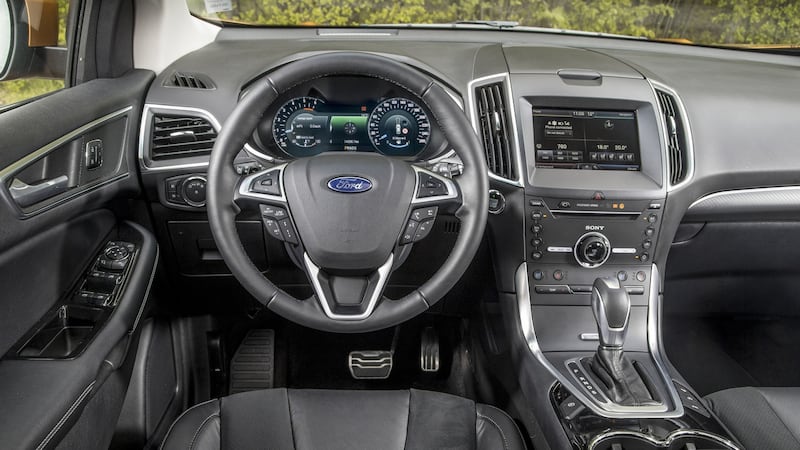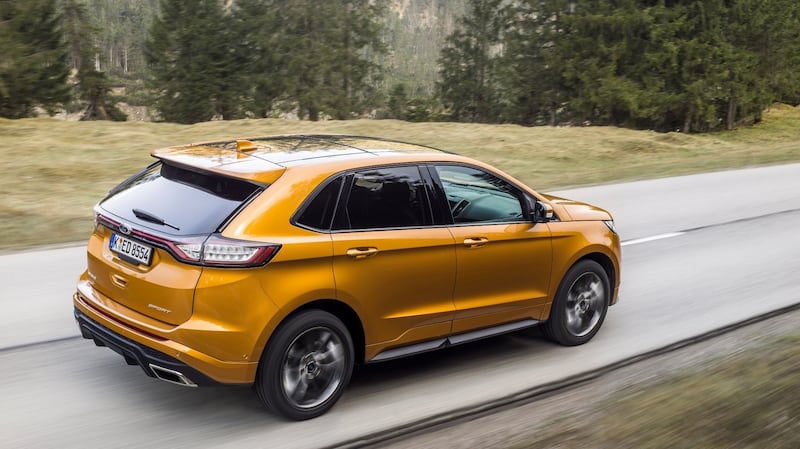It’s the age of the SUV. The family saloon is old hat, the people carrier a symbol of familial sacrifice. Both formats are haemorrhaging sales to the SUVs and crossovers.
Even hatchbacks are losing out to these higher-set vehicle formats. The best-selling car in Ireland is not longer the Ford Focus or the VW Golf: it's the Hyundai Tucson. Once motorists get their bums onto the raised seating positions of these crossover/SUVs, there's no going back.
For the established brands - whose fat bank balances have been built on the back of three-box cars - this has caused a bit of a quandary. Few were really prepared for the popularity of these cars. Hence Ford’s delay in getting its crossover and SUV act in gear. All the more puzzling given the firm’s strong base in SUVs and so-called “trucks” in its home market.


The Kuga filled a gap for some, but it’s only in the last year that sales have come to match those of Asian rivals. Now Ford is launching what will be the flagship of its SUV range to date: the Edge.
Smart styling
The car itself is a smartly-styled, sizeable family crossover, ready to challenge the likes of the Hyundai Santa Fe but harbouring ambitions for conquest buyers from the premium ranks, taking on the Volvo XC90, Audi Q5 and BMW X3.
Its styling reflects its scale but it has been well executed. There is a nod towards Americana with the creases on the bonnet - not unlike the new Mustang - but little touches like the rear lights running across the rear give it a look that makes some premium rivals seem a little dull. And when parked up against its smaller sibling, the Kuga looks quite small and mundane.
The Edge has been on sale in the US, but for the launch of this new version Europe was called upon for its input on chassis dynamics along with bringing the fit and finish up to standard for tastes on this side of the Atlantic.
The cars arriving from July will be built in Ford's assembly plant in Oakville, just outside Toronto, Canada. Many of the parts, however, will originate in Europe. For example the diesel engines and dashboards all start out in Europe, while the chassis is the same as that developed by engineers in Europe for the Mondeo, Galaxy and S-Max. The extra height for the Edge comes from adjustments to the shocks and suspension settings.
The decision to continue production in North America perhaps reflects a lingering doubt amongst the product planners about Europe's long-term love for SUVs.
They should harbour no such qualms. There are some rough edges to this new arrival, such as the quality of the plastics on some parts of the dash, but I suspect this Ford will be well received.
The Edge is available in two versions of a 2-litre diesel: either 180bh or 210bhp. The latter, which is sold with automatic transmission is the best option, though the lower-powered manual is expected to be the best seller.
Both are fine about town but the extra 30bhp makes a noticeable difference in terms of refinement, while the automatic is more in tune with the driving needs of potential Edge buyers.
Two trim grades are on offer: Sport and Titanium. From our initial time in the car we’d opt for Sport auto 210bhp over the 180bhp Titanium manual. For these large cars, colour can be key, but Ford has done well here with a really impressive electric orange version on black alloys that really set off the curves and creases on the car.
Spacious interior
In terms of interior space, Ford engineers are quick to point out that the Edge boast more room than rivals like the Volvo XC60 or Audi Q5. Certainly, there's enough legroom for adults in the back, ample space in the front, while you can fit two Isofix child seats and a booster seat across the back row. The lack of a third row is a strange omission - particularly as there's a seven-seat Edge variant on offer in China - but it seems Ford has decided if you need all those seats you are really better in an S-Max or Galaxy.
As is the rule for these family-orientated cars, it is awash with sockets for laptops and chargers. In the back there is even a universal 230-volt socket ready for any three-pin plug, so you can take along your kettle and get the rear seat passengers to catch up on some ironing while on the move.
The Edge comes in all-wheel drive as standard, featuring Ford's all-wheel drive system that monitors the torque - or grip - on each wheel every 16 milliseconds and then adjusts the power supply to maximise traction in the vehicle. While we only got to test it out on a rather tame muddy forest track, the engineers spoke of perfecting the system in the winter ice and snow of northern Michigan.
The steering feel sometimes lacks a little in terms of feedback. In terms of refinement in the cabin, Ford has worked hard to reduce engine noise, with an active noise cancelling system fitted as standard, while the Edge also boasts acoustic glass. For all that, the diesel rumble is still quite loud above 2,000 rpm.
Pricing
For all that the Edge comes very close to delivering a premium feel. Certainly the outside styling is as sharp as anything out there and the interior space is impressive. Prices for the Edge start at €55,700 for the Titanium version, the highest entry price for any Ford on sale at present. That’s significantly more than the key Asian rival, the Hyundai Santa Fe, which starts at €39,995 in two-wheel drive and €43,995 in four-wheel drive. It also features seven seats. At the premium end the BMW X3 starts at €46,000, while the Volvo XC60 enters the market at €39,495.
These prices mean the Edge will have to fight really hard for its sales. Perhaps there will be enough of a following for the Blue Oval brand to deliver significant numbers. And the specifications are quite high, with no poorly-equipped base model in the range. However, a price review might be in order if Ford really wants to get an Edge in this burgeoning market.
Lowdown: Ford Edge
Engine: 2-litre diesel with 180bhp in either auto or manual or 210bhp in auto
L/100km: 5.8 l/100 km (48.7 mpg),
Emissions; 149 g/km
0-100km/h: 9.9 seconds (180bhp); 9.4 seconds (210bhp)
Price: Starting at €55,700 for the 180bhp manual with Titanium specification












